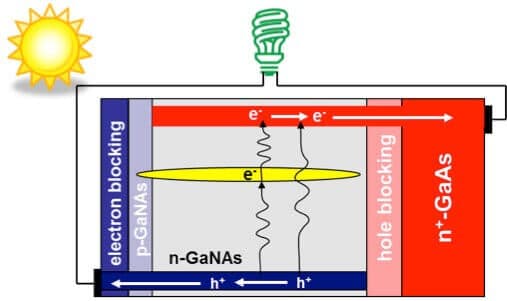When visiting California’s central valley in the summertime, it’s hard to imagine that solar energy isn’t single-handedly meeting the west coast’s energy needs. But one problem with modern solar cells is that while the solar spectrum covers a wide range of energies they can only harness light of a single energy,. This means that very little of the available energy is actually captured.
One potential solution is an intermediate band solar cell, comprising an intermediate band built into a wide-gap semiconductor. But in order for the cell to work, incident photons must be able to transfer charge using all three band transitions (valence-intermediate ; intermediate-conducting ; and conducting-valence), in a process known as optical absorption. That’s the difficult part. Now, for the first time, Berkeley Lab researchers have engineered an alloy solar cell and demonstrated that optical transitions do indeed occur in all three cases.
“It’s difficult to find a material system with all three optical transitions, and it is even more difficult to show that the transitions occur simultaneously,” explains Wladek Walukiewicz, senior staff scientist at Berkeley Lab’s Materials Sciences Division. “Normally, people use selective excitation to test a material’s optical coupling. One light source induces a transition from the valence to intermediate band; and another from intermediate to conduction. But in this way, it’s very hard to tell which photon was the excitation soure.”
Walukiewicz authored a paper titled “Multicolor Electroluminescence from Intermediate Band Solar Cell Structures” about this research in the journal Advanced Energy Materials. Co-authors include Nair Lopez, Kin-Man Yu, and Tooru Tanaka.
Instead of looking for absorption of photons, Walukiewicz decided to experiment with photon generation. A semiconductor can be used in two ways: as in a solar cell, an absorber to produce electricity; or as in an light emitting diode (LED) where, in a process known as electroluminescence, application of external voltage produces light. The Berkeley team showed that application of a voltage to their previously developed intermediate band solar cell structures leads to emission of photons. They simultaneously observed two electroluminescence peaks corresponding to the optical transition energies expected in the cell structure.
“If you can observe electroluminescent emission, you can infer that absorption of the same energy will also occur,” adds Walukiewicz. “With a normal diode, you see one peak which is related to the bandgap. In our case, you see how two different gaps produce two color emissions.”
The key to success was the Walukiewicz team’s previous discovery of alloys that allowed them to engineer semiconductor band gaps. They showed that incorporating nitrogen into semiconductor gallium arsenide results in the formation of GaNAs alloy that has a third intermediate band. For this study, structural variations with a blocked intermediate band confirmed that electroluminescent peaks originated from transitions between the intermediate and the conduction and valence bands.
Not only did the experiment show the optical transitions which are key for an intermediate band solar cell to perform, but it also opened a potential for using modified cell structure as a multicolor light emitter.
“The direct demonstration of the optical coupling between different bands…will have a positive impact on the field of high efficiency solar cells,” says co-author Nair Lopez, a physicist now at Universidad Autónoma de Madrid. Now that optical transitions are proven to exist, she will “work on optimization of the material properties and device design to improve the solar power conversion efficiency. Additionally, we are trying with new alloys to produce multiband solar cells.”
To make an energy efficient technology, solar cell absorption must be improved. But proving that a single material can establish optical transitions across the solar spectrum is a critical step on the sunny path to a competitive product.
This research was funded by the U.S. Department of Energy’s Office of Science.

